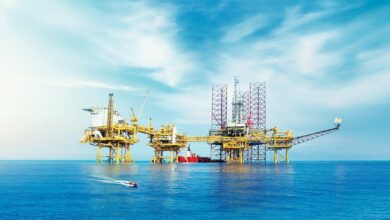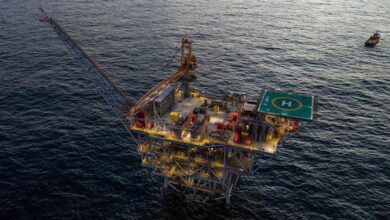Drill pipe riser system qualified for African deepwater project
Enhanced deployment control, extended-depth capability among key drivers for DPRIS selection; 20 runs have been performed offshore Nigeria since 2010
By Christophe Rohart, Henri Williams, Yannick Mfoulou, VAM Drilling
The Cameron/TOTAL Usan project team took one of the first high-pressure drill pipe riser for intervention systems (DPRIS) to the African deepwater market in 2009.
Since July 2010, the string has been used offshore Nigeria. A total of 20 runs have been performed with this DPRIS for the installation of four trees. These trees have had no cleaning issues and no rust debris impacting operations.
Proper operating procedures have allowed for safe and efficient subsea DPRIS runs to date and provide confidence in future runs (38 more trees are planned).
The pipe delivered as part of this project are drill pipe risers with a proprietary double shoulder connection and featuring a gas-tight metal-to-metal seal on the inner shoulder.
The standard offer for high-pressure drill pipe riser (DPR) is 6 5/8 in., 0.5 in. wt and X-95 grade. VAM Drilling suggested a change to a thick wall for corrosion allowance and higher grade for tensile strength, 6 5/8 in., 0.625 in. wt and G-105 grade.
The qualification program covered all remaining requirements for full compliance with ISO-13628-7.
The DPRIS system delivered in West Africa is a cost-efficient solution for subsea operations, workover applications and well intervention.

Project context
The Usan field lies offshore Nigeria in Block OML 138, approximately 100 km south of the Nigerian coastline. Water depth ranges from 660 meters to 820 meters. Field owners include operator EPNL-TOTAL and its partners Chevron, ESSO and EPNL-Nexen.
Subsea facilities are arranged around an FPSO and made up of 23 production wells, 10 gas-injection wells and nine water-injection wells. There is a potential for up to 32 production wells, bringing total well count to 42. Each will be fitted with a subsea tree, installed at the seabed.
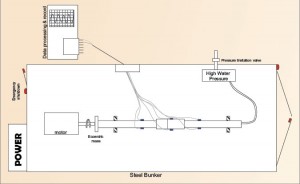
Drivers for DPRIS selection
Before DPRIS, most operators used conventional drill pipe available on rigs to install and retrieve the production adapter base and tree cap. These were simple, open-water operations that did not require annulus control, pressure containment or fluids circulation.
Occasionally companies used drill pipe as a work string in tubing hanger retrieval operations. Pipe could be deployed with a hydraulic jar to unstick tubing hangers. While success varied, the difficulties and risks of using a hydraulic umbilical inside the riser were identified. Technology improvement was needed to minimize interference between the pipe and the hydraulic lines.
The existing designs for dual vertical-bore risers were adequate for shallow-water completions, but as subsea completions moved to increasingly deeper waters, risers became a more costly and less desirable solution.
Today, drill pipe risers:
Serve as running string for the installation and retrieval of subsea trees and tubing hangers;
Provide an improved flow path for annulus access of circulation;
Are fully NACE-compliant for the most extreme sour-service environments;
Provide a conduit to the surface vessel for well production testing and wireline or coiled-tubing services; and
Can be run in open sea mode and inside drilling riser and BOP systems.
Main drivers for the use of DPRIS in the Usan field were:
Operations safety;
Better control of the deployment process;
Large production bore;
Ability to run an umbilical along with the tree; and
Extended depth capability for deepwater operations.
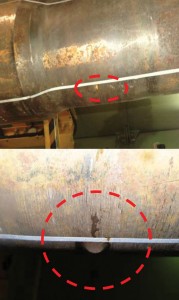
High-Pressure DPR design
Pipe design
A 6 5/8-in. OD drill pipe was selected to meet the minimum drift requirement. Although this dimension has become an industry standard for DPR systems, for non-operation, normal operation, extreme operation and accidental conditions, the considerations for pipe design included:
Water depths between 650 meters and 900 meters;
1-year and 10-years return period;
Currents and swell heights in the Nigerian region;
The expected or allowable vessel motion defined by the maximum percentage of water depth; and
Vessel deviation.
This study highlighted that the standard offer for high-pressure DPR, 6 5/8 in., 0.5 in. wt and X-95 grade, did not provide a sufficient safety margin when considering the worst operational conditions with the assumed 3-mm corrosion/wall thickness tolerance allowances.
The minimum wall thickness requirements for the standard pipe joint are calculated to resist loading due to internal pressure, external pressure and combined loading effects between tension, bending and external pressure. All dimensions were chosen in accordance with API RP 2RD for all operating conditions, including pressure test operations. The different criteria evaluated as failure mechanisms during operation were:
In-service – burst;
In-service – collapse;
In-service – buckling; and
Hydrotest – burst.
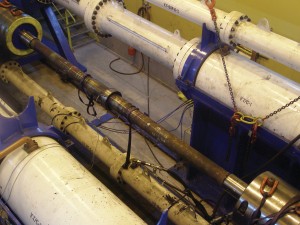
When considering burst analysis, API 2RD provides the formula for calculating the Von Mises stress, which depends on the radial, hoop and axial stress. For a pipe, the upper region of the riser assembly experiences high tensile stresses due to high tension loads caused by the lower assembly. The lower region experiences high radial and hoop stresses due to the hydrostatic pressure in and out of the riser system. Thus, burst analysis must be performed at all locations throughout the riser assembly. Yield strength steel for the riser pipe material was assumed to be 105,000 psi. The maximum internal pressure considered in the open-water mode is the design pressure of 5,000 psi. The riser tension is calculated assuming 50 Te tension at the top of the EDP.
Performance levels of other product lines, as well as improvements on the processes within manufacturing, were combined to give birth to a new DPR offer. The option had thicker wall for corrosion allowance and higher grade for tensile strength, (6 5/8 in., 0.625 in. wt and G-105 grade). It also became at this stage that the connection’s mechanical resistance associated with the new pipe had to be improved when upgrading the forging properties from 110,000-psi to 120,000-psi minimum yield strength.
The nominal wall thickness of the standard joint supplied is 0.625 in. An allowance of 3 mm is assumed in the calculation to account for the material loss at any point on the riser; this assumption accounts for a reduction of wall thickness due to external corrosion and wall thickness tolerance. This material loss is assumed to be uniform and to occur on the entire pipe wall.
The dominating condition is burst at the surface due to design pressure and tension. The critical wall thickness requirement is found in the marine riser mode, where a nominal wall thickness of at least 0.51 in., including corrosion allowance, is required for the standard pipe joint.
With the designed nominal wall thickness, calculated maximum bending in open water mode with the 5,000-psi design pressure and 50 Te base tension was evaluated at 450,184 lbs-ft.
Connection design
The gas-tight seal in the first-generation DPR connection is achieved with a Teflon seal ring close to the external shoulder. The metal-to-metal seal of the second-generation DPR is located close to the internal shoulder of the tooljoint.
This design solution allows for reduced contact pressure on the sealing surface, improving stability of the seal contact and reducing the possibility of early galling. Further, due to the position of this seal, gas pressure migration from the internal diameter into the connection is avoided. To achieve the stable behavior of the metal-to-metal seal for the range of possible interferences due to production tolerances, the design incorporated a double radii, or wave effect, in the ¼-in. taper seal area.
With two contact surfaces, the solution offers a better contact pressure distribution and reduces the risk of galling without reducing seal performance. Having the seal close to the internal shoulder also benefits the connection design as it provides consistent and stable contact pressure under combined loads.
Design improvements on the second-generation DPR included a proprietary thread profile. This modified API thread form features a reduced angle on the loading flank to reduce the sensitivity of the connection to high axial tension. It also provides better control of the sealing zone. Other changes include a larger pitch diameter for a better balance between pin and box critical cross-sections and a reduction of the threads per inch to guarantee quicker makeup. The thread root radius was increased for better fatigue resistance. A stress relief groove was added on the box to avoid dope pressure entrapment for better fatigue behavior.
Qualification program
By calculation and finite element analysis, it was demonstrated that the majority of the qualification tests results for 110,000-psi connections was transposable to 120,000-psi connections. Thus, a reduced test plan was agreed upon between the field user and the product manufacturer to validate the new 120,000-psi configuration according to ISO13628-7:2005 in consideration of the Usan field loadings.

Transposable results were:
Connection robustness to 100 make and breaks already validated on seven samples;
Connection robustness to round robin test validated on three connections;
Combined load tests validated on three connections at 15,000 psi and 1,000 kips;
External pressure water leak tightness validated on three connections at 10,000 psi; and
Connection burst test without leak until 30,000 psi internal water pressure.
New validation tests:
Resonant fatigue test with mean tension applied by 5,000 psi internal water pressure;
Temperature cycles tests between 121°C and -18°C;
Low-pressure test before and after temperature cycling; and
Third-party witness of all tests and approval on qualification documentation.
Fatigue tests with mean tension
All samples for Usan DPRIS qualification were extracted from actual production. Thus, the connection had standard machining tolerances and the material, the surface treatment, and the welding process were fully representative of the delivered drill pipe risers.
Fatigue samples were cut at length, and end caps were welded at both ends. Pin and box were made-up in a manner to have the tooljoint as centered as possible in the middle of the resonant fatigue frame. The tooljoint alignment in the middle of the sample is strategic to generate a symmetrical bending moment along the sample and to avoid creating artificial overloading on one side compared with the other.
The fatigue sample is fixed with belts on wheels, and six strain gauges are glued in pairs on three sections. This setup allows for measuring the micro-deformations on the connection OD but also at the pipe section pin side and box side.
Having strain gauges facing at 180° gives information on the symmetrical vibration of the DPRIS and gives a back-up record in case of cable damage.
A hydraulic proof test was performed on each sample before fatigue testing to confirm assembly integrity. As recommended by the ISO standard, a pressure of 7,500 psi, representing 1.5 times working pressure, is applied during 3 min then 15 min. No leak was observed.
Three of the DPRIS were submitted to resonant fatigue at three stress levels and with 5,000-psi internal water pressure. The test was continued until a pressure drop of 250 psi was detected.
All fatigue failures were detected due to leaks caused by cracks. All failures occurred in the pipe upset zone and after a longer cyclic time than the minimum specified. The upset zone is known as a weak part of the drill pipe in terms of fatigue and is the location where maximum bending stress is measured during a resonant fatigue test. These results were therefore conclusive.
A fourth DPRIS was submitted to 500,000 fatigue cycles, then submitted to 80% pipe body yield strength in tension at low internal pressure. No leak was detected; thus, the sample was continued in resonant fatigue until failure.

Temperature cycling with pressure cycling test
ISO 13628-7:2005 refers to ISO 10423:2003 F.1.11 for the definition of the test protocol to be conducted for pressure and temperature cycles. The field user needed a qualification of the connection to temperature class U (i.e., between 121°C and -18°C). It was identified that in some workover operations with nitrogen injection by coil tubing inside the riser string, there may be an opportunity for low temperatures at the connection level. A DPRIS from production with standard dimensions, standard surface finish and friction welded using standard processes was prepared with proprietary end fixings.
This connection was first subjected to a series of 100 make and breaks. The connection was inspected, and fresh dope reapplied every two make and breaks. No galling was observed during or after the 100 make and breaks. A leak path was cut on the external and internal torque shoulders in a manner to ensure that the metal-to-metal gas-tight seal was the only effective seal during the test.
The hydraulic proof test was then conducted in the same manner as for other fatigue samples. An assembly of cooling copper coil, temperature insulation covers and heating coil was fitted around the sample before placing it in the 1,350-ton static test frame.
Internal gas pressure was applied using a mixture of 90% nitrogen and 10% helium. The leak detection was achieved via a helium spectrometer calibrated to identify a leak of 10-4 N. cu cm/sec (equivalent to 0.36 N. cu cm/hr or 0.9 cu cm/15 min). To validate the functionality of the detector during the test, a measure of the quantity of helium in the air was performed at the beginning and at the end of the test. The level measured needed to fall between 3.10-6 and 7.10-6 N. cu cm/sec.
During the full test, the temperature did not exceed limits by more than 11°C, and the pressure remained stable above 5,000 psi and with variation under 250 psi/hr during the one-hour qualification process as required by the ISO standard.
The DPRIS solution delivered to the Usan field passed the fatigue tests, wearing test and temperature cycling test, in addition to the existing qualification data.
Final factory acceptance tests were conducted on 100% of the production pipe, with internal water pressure at 7,500 psi; 10% of the production pipe was tested with internal water at 10,000 psi followed by internal gas pressure at 5,000 psi. All pipe and connections remained tight and were accepted for operations.
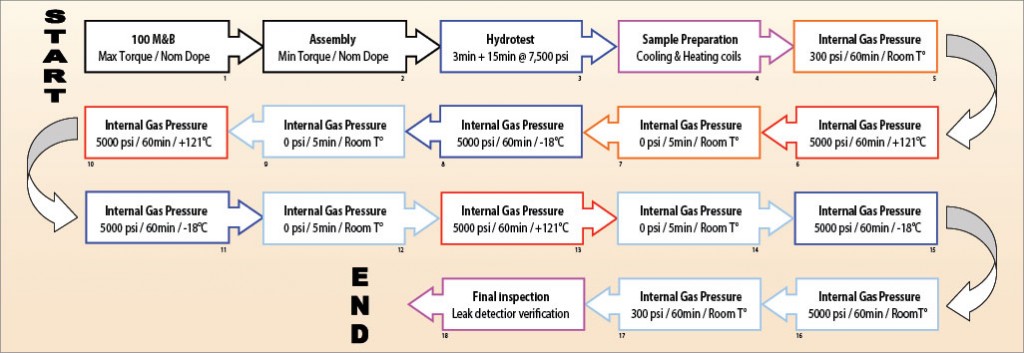
Operations
Of the 20 runs that have been performed offshore Nigeria since July 20, 12 were done inside riser and eight in open hole, installing and testing four Christmas trees. Only the first set of tools was used for these operations, and there have been no cleaning issues and no rust debris impacting operations. One joint was eventually damaged due to overtorque at the rig floor.
Pressure tests were performed at almost each run, at a minimum water pressure level of 5,000 psi. The string presented no leakage during any pressure tests. No NPT related to this DPR system has been reported to date.
Lessons learned
Long-term planning has proven key for the qualification of these DPRIS. Although it is too early to call the deployment a complete success, the smoothness of the operations thus far provide confidence in future DPRIS runs.
This DPRIS is being run more smoothly, quicker and safer than in previous experiences on the African shelf.
It is important to highlight the good communication practices established before, during and after deployment of the solution. Training and technical documentation was provided in advance to the field user to ensure proper utilization of the products offshore.
Beyond manufacturing and R&D, inspection, repair and maintenance must also be planned. This network is essential when deploying the DPRIS solution. Regular inspections must be carried out at the rig site by field personnel, and a visual inspection of pipe and threads must be performed after each run. Runs can last between two to 33 days in this field. The rig inventory is replaced once a year and sent onshore, where a full inspection is carried out on internal and external parts of the pipe and threads; defects on the OD and wall thickness are also inspected.
This article is based on a presentation at the 2012 IADC/SPE Drilling Conference, 6-8 March, San Diego, Calif.


